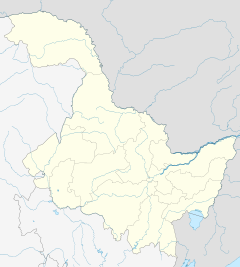| Bukui Mosque | |
|---|---|
卜奎清真寺 | |
 | |
| Religion | |
| Affiliation | Sunni Islam |
| Location | |
| Location | Qiqihar, Heilongjiang, China |
| Geographic coordinates | 47°21′2.5″N 123°57′2.5″E / 47.350694°N 123.950694°E |
| Architecture | |
| Type | mosque |
| Completed | 1684 (East Mosque) 1852 (West Mosque) |
Bukui Mosque ( Chinese: 卜奎清真寺; pinyin: Bǔkuí Qīngzhēnsì) is a mosque in Qiqihar, Heilongjiang, China. It is located in Mosque Road (Chinese: 清真路; pinyin: Qīng Zhēn Lù) off Bukui Street. [1] It was built during the Qing dynasty, and listed in 2006 as a Major Site to Be Protected for Its Historical and Cultural Value at the National Level. [2] [3] It is the largest and oldest mosque in the province. [4]
History and structure
The name "Bukui" is the Chinese transcription of a Daur word meaning "auspicious". [1] Bukui Mosque originally consisted of two separate mosques: [2]
- The East Mosque, a three-storey, 374 square metre building constructed in Kangxi 23 (1684), predating the city of Qiqihar by seven years [2]
- The West Mosque, a two-storey, 173 square metre building constructed in Xianfeng 3 (1852) by followers of the Jahriyya menhuan who immigrated from Gansu [1] [2]
The mosque contains roughly 2,000 square metres of constructed space; the whole compound covers an area of roughly 6,400 square metres. The two prayer spaces together can hold a total of roughly 450 people. [2]
The mosque's long history has led to a saying in Qiqihar: "the mosque existed long before the town Bukui". [n 1] [5] In 1958, the two mosques were reorganised as a single mosque, with the name "Qiqihar Mosque". The mosque was listed as a city-level protected cultural relic in 1980, and as a provincial-level protected cultural relic in 1981; its name was then also changed to the present "Bukui Mosque". [2] An assessment done that year found that while the East Mosque was in relatively good condition, there was serious structural damage to the West Mosque. [6] Reconstruction efforts were undertaken in 1989–1990. [3] On 25 June 2006, the State Council of the People's Republic of China entered Bukui Mosque onto the sixth batch list of Major Sites Protected at the National Level. [3]
See also
- Islam in China
- List of mosques in China
- List of famous mosques
- Timeline of Islamic history
- Islamic architecture
- Islamic art
- List of mosques
Footnotes
- ^ simplified Chinese: 先有清真寺,后有卜奎城; traditional Chinese: 先有清真寺,後有卜奎城; pinyin: Xiān yǒu qīngzhēnsì, hòu yǒu Bǔkuíchéng.
References
- ^ a b c 卜奎清真寺, MOOK 自游自在 (in Chinese), pp. 79–81, 2001, ISBN 957-667-787-4
- ^ a b c d e f 卜奎清真寺, Qiqihar News (in Chinese (China)), 2005-06-27, archived from the original on 2016-03-03, retrieved 2010-09-11
- ^ a b c 卜奎清真寺 (in Chinese), China Cultural Heritage Foundation, retrieved 2010-09-11[ permanent dead link]
- ^ 黑龙江规模最大的伊斯兰建筑:卜奎清真寺, Xinhua News (in Chinese (China)), 2008-12-12, archived from the original on 2012-03-12, retrieved 2010-09-11
- ^ 齐齐哈尔第三集, China Central Television (in Chinese (China)), 2005-08-29, retrieved 2010-09-11
- ^ Liu, Peilin (刘沛霖) (1981), 卜奎清真寺, 学习与探索 (in Chinese (China)), retrieved 2010-09-11
External links
- Photos of the Bukui mosque (in French)
